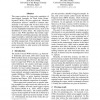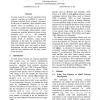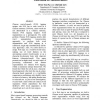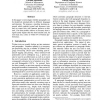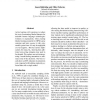EMNLP
2004
15 years 1 months ago
2004
This paper introduces an approach to sentiment analysis which uses support vector machines (SVMs) to bring together diverse sources of potentially pertinent information, including...
EMNLP
2004
15 years 1 months ago
2004
This paper explores the large-scale acquisition of sense-tagged examples for Word Sense Disambiguation (WSD). We have applied the "WordNet monosemous relatives" method t...
130
click to vote
EMNLP
2004
15 years 1 months ago
2004
We compare and contrast two different models for detecting sentence-like units in continuous speech. The first approach uses hidden Markov sequence models based on N-grams and max...
104
click to vote
EMNLP
2004
15 years 1 months ago
2004
In most research on concept acquisition from corpora, concepts are modeled as vectors of relations extracted from syntactic structures. In the case of modifiers, these relations o...
102
click to vote
EMNLP
2004
15 years 1 months ago
2004
We present a data and error analysis for semantic role labelling. In a first experiment, we build a generic statistical model for semantic role assignment in the FrameNet paradigm...
125
Voted
EMNLP
2004
15 years 1 months ago
2004
This paper takes a critical look at the features used in the semantic role tagging literature and show that the information in the input, generally a syntactic parse tree, has yet...
101
click to vote
EMNLP
2004
15 years 1 months ago
2004
Chinese part-of-speech (POS) tagging assigns one POS tag to each word in a Chinese sentence. However, since words are not demarcated in a Chinese sentence, Chinese POS tagging req...
108
Voted
EMNLP
2004
15 years 1 months ago
2004
In this paper we investigate whether paragraphs can be identified automatically in different languages and domains. We propose a machine learning approach which exploits textual a...
100
Voted
EMNLP
2004
15 years 1 months ago
2004
We perform Noun Phrase Bracketing by using a local, maximum entropy-based tagging model, which produces bracketing hypotheses. These hypotheses are subsequently fed into a reranki...
103
click to vote
EMNLP
2004
15 years 1 months ago
2004
Active learning (AL) promises to reduce the cost of annotating labeled datasets for trainable human language technologies. Contrary to expectations, when creating labeled training...

